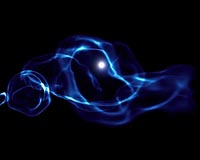 |
Hanover NH (SPX) Aug 24, 2009 Despite their popularity in the science fiction genre, there is much to be learned about black holes, the mysterious regions in space once thought to be absent of light. In a paper published in the Physical Review Letters, the flagship journal of the American Physical Society, Dartmouth researchers propose a new way of creating a reproduction black hole in the laboratory on a much-tinier scale than their celestial counterparts. The new method to create a tiny quantum sized black hole would allow researchers to better understand what physicist Stephen Hawking proposed more than 35 years ago: black holes are not totally void of activity; they emit photons, which is now known as Hawking radiation. "Hawking famously showed that black holes radiate energy according to a thermal spectrum," said Paul Nation, an author on the paper and a graduate student at Dartmouth. "His calculations relied on assumptions about the physics of ultra-high energies and quantum gravity. Because we can't yet take measurements from real black holes, we need a way to recreate this phenomenon in the lab in order to study it, to validate it." In this paper, the researchers show that a magnetic field-pulsed microwave transmission line containing an array of superconducting quantum interference devices, or SQUIDs, not only reproduces physics analogous to that of a radiating black hole, but does so in a system where the high energy and quantum mechanical properties are well understood and can be directly controlled in the laboratory. The paper states, "Thus, in principle, this setup enables the exploration of analogue quantum gravitational effects." "We can also manipulate the strength of the applied magnetic field so that the SQUID array can be used to probe black hole radiation beyond what was considered by Hawking," said Miles Blencowe, another author on the paper and a professor of physics and astronomy at Dartmouth. This is not the first proposed imitation black hole, says Nation. Other proposed analogue schemes have considered using supersonic fluid flows, ultracold bose-einstein condensates and nonlinear fiber optic cables. However, the predicted Hawking radiation in these schemes is incredibly weak or otherwise masked by commonplace radiation due to unavoidable heating of the device, making the Hawking radiation very difficult to detect. "In addition to being able to study analogue quantum gravity effects, the new, SQUID-based proposal may be a more straightforward method to detect the Hawking radiation," says Blencowe. In addition to Nation and Blencowe, other authors on the paper include Alexander Rimberg at Dartmouth and Eyal Buks at Technion in Haifa, Israel. Share This Article With Planet Earth
Related Links Dartmouth Understanding Time and Space
 First Black Holes Kept To A Strict Diet
First Black Holes Kept To A Strict DietGreenbelt MD (SPX) Aug 12, 2009 A new supercomputer simulation designed to track the fate of the universe's first black holes finds that, counter to expectations, they couldn't efficiently gorge themselves on nearby gas. The findings have implications for understanding the formation of galaxies and of the giant black holes that reside in their centers. "The first stars were much more massive than most stars we see today ... read more |
|
| The content herein, unless otherwise known to be public domain, are Copyright 1995-2009 - SpaceDaily. AFP and UPI Wire Stories are copyright Agence France-Presse and United Press International. ESA Portal Reports are copyright European Space Agency. All NASA sourced material is public domain. Additional copyrights may apply in whole or part to other bona fide parties. Advertising does not imply endorsement,agreement or approval of any opinions, statements or information provided by SpaceDaily on any Web page published or hosted by SpaceDaily. Privacy Statement |